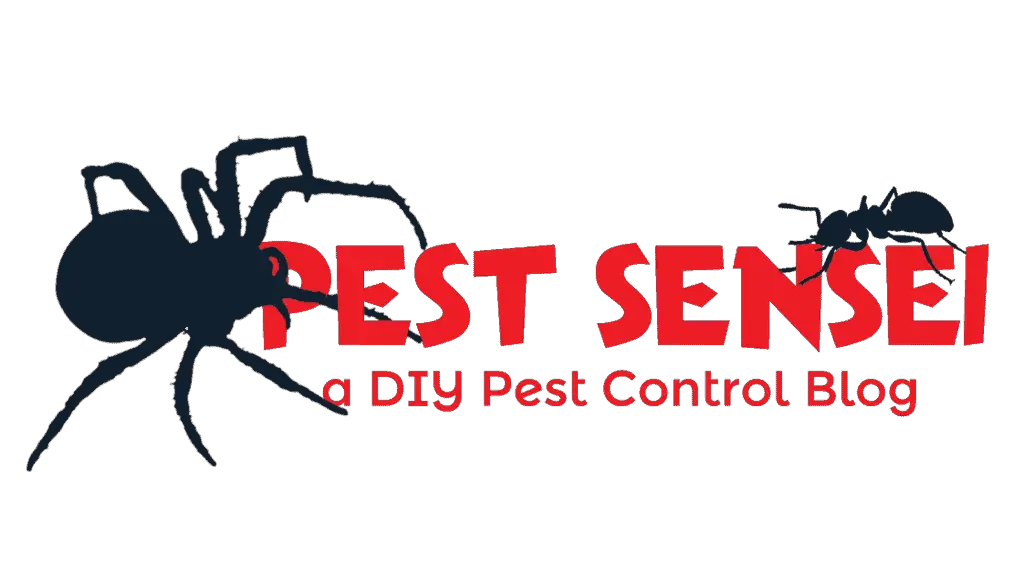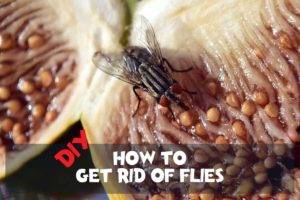Flies are filthy creatures that can contaminate our food due to their behaviors. On top of that, its presence itself is an annoyance. In this guide, I’ll teach you how to get rid of flies in your house using various DIY methods, without harmful chemicals.
Understanding Flies
Flies are insects with 2 wings. There are different types of flies, such as house flies, fruit flies, fungus gnats, drain flies, etc. Dragonflies and butterflies are not “flies”, because they have 4 wings. Note there is a space before the word “flies”.
Flies primarily feed on decaying or fermenting organic matter and also human food, thereby transmitting disease-causing pathogens when they move between unsanitary food sources and our meals.
The larval stage of flies is known as maggots, which resemble legless worms. They can be either white or black. Maggots feed until they transform into pupae, typically relocating from moist organic matter to a dry environment to undergo pupation.
The diversity of flies exceeds 100,000 species. They can be categorized into two groups: non-biting flies, the focal point of this article, and biting flies. For simplicity, we can further classify non-biting flies into filth flies and small flies.
Filth Flies
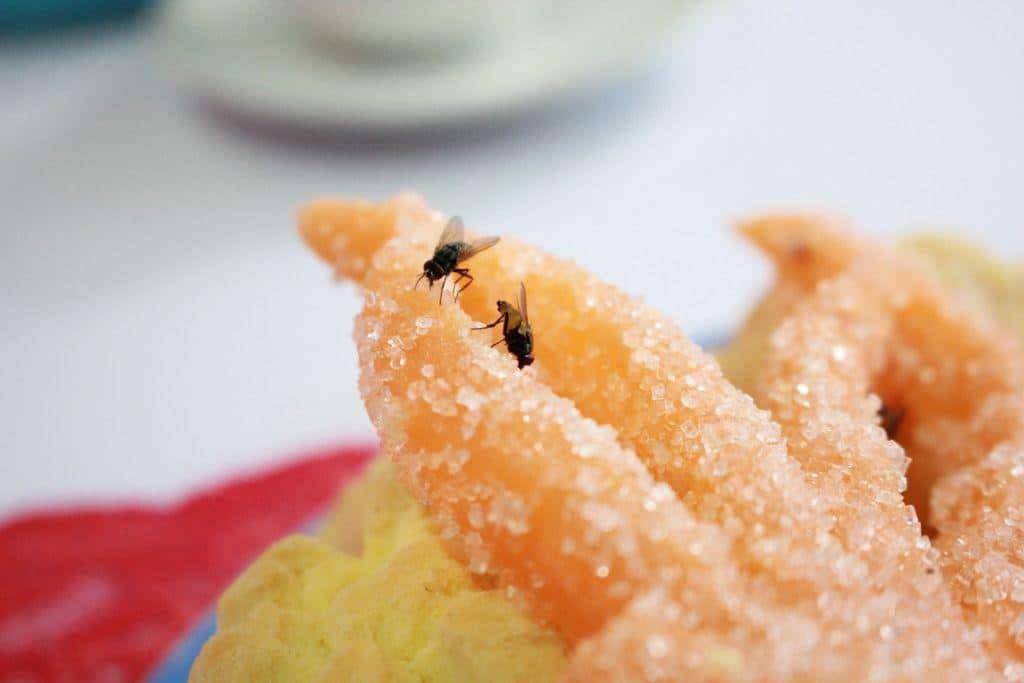
Filth flies, which include house flies, flesh flies, blow flies, and bottle flies, are larger non-biting flies with the ability to cover considerable distances due to their size. For example, house flies can travel up to 1-2 miles in search of suitable breeding grounds or food sources.
In homes, infestations of filth flies are commonly caused by external breeding grounds, often associated with decaying animal matter.
Small Flies
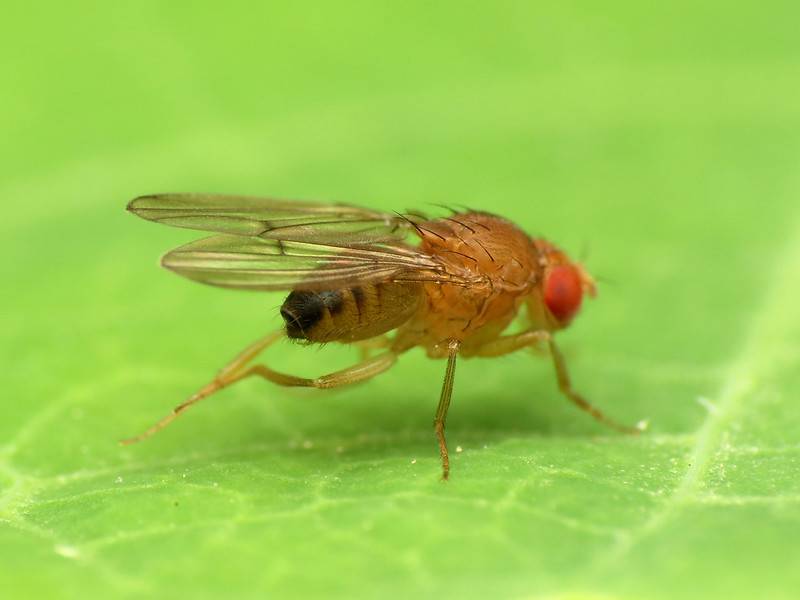
Small flies, such as fruit flies, drain flies, phorid flies, eye gnats, and fungus gnats, are tiny non-biting flies incapable of flying long distances due to their small size.
Infestations of small flies within homes typically originate from breeding grounds found within the house, commonly associated with fermenting plant matter.
What Causes Fly Infestation at Home?
The presence of food or suitable breeding grounds is the underlying cause of fly infestations in homes. Flies can either breed within your house, utilizing sources like rotten food, garbage, fallen leaves, open compost, and drains, or they may enter from external breeding grounds through open windows in search of food.
Identifying the breeding grounds for flies within homes may not always be obvious. Most homeowners take diligent measures to maintain proper housekeeping, ensuring that spoiled food, food waste, and pet waste are promptly taken care of. But yet, they are plagued with fly issues.
It’s worth noting that flies can breed in unexpected places beyond just garbage. Locations such as drains, plumbing traps, mops, and fallen leaves can serve as breeding grounds for flies. Addressing these areas can effectively resolve the issue of flies in your home.
Filth flies possess a remarkable ability to detect food odors from several miles away, enabling them to fly directly to the source. Many of you may have experienced this firsthand: as you prepare your lunch, flies quickly gather, drawn by the enticing aroma of the meal.
Interestingly, flies are most active during the day and are less likely to disturb you during dinner hours, as that is their resting time.
How to Get Rid of Flies at Home?
Getting rid of flies is very straightforward. Often, it can be done without using any harmful chemicals. Even a significant infestation can be dramatically reduced if the right methods are employed.
Let’s explore 11 proven do-it-yourself (DIY) techniques that are effective for dealing with different types of flies. It’s important to identify the specific type of flies you are facing before selecting the appropriate method.
Install Windows and Door Screens
If you are dealing with filth flies like house flies and blow flies, installing fly screens on your windows and doors can provide quick relief. These screens act as barriers, preventing flies from entering your living spaces.
I started working from home when the Covid-19 pandemic hit. That’s when I noticed I had a fly issue, house fly to be exact. The breeding ground is at the park down the street, where leaves fall down every day. Someone would sweep the leaves to the side daily, but the leaves are only disposed of once a week or so. In fact, the park has later become a free source of feeder flies for my pet mantis 🙂
The house flies “swarm” into my house every afternoon. I bought some sticky papers and a fly swatter, and I managed to catch and kill 40-50 flies daily! But that’s just not sustainable!
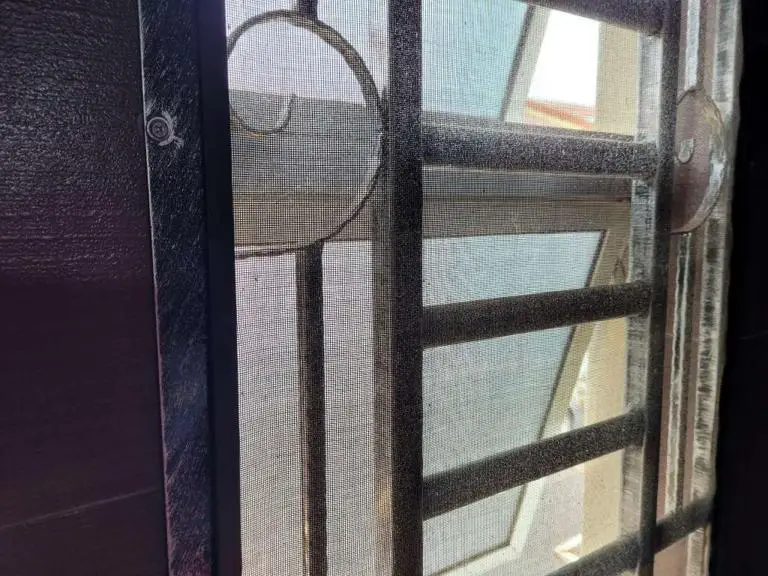
I decided to purchase magnetic fly screens. After installing the screen on all my windows, I observed a significant reduction in the number of flies. Instead of dealing with 50 flies every day, I now only encounter 1-2 flies per week. It seems that flies occasionally enter when we leave the doors open. The best part is that I haven’t needed to use any insecticides.
The size of the magnetic fly screen is customizable. You can cut the screen and frame into a desired size and assemble it. The screen attaches tightly to the window frame through the included magnetic stripes.
Remove Fly Breeding Grounds
Whenever possible, finding and addressing the breeding ground should be your top priority. Flies are attracted by and breed in moist, decaying organic matters. Look around your house, identify those spots and fix them.
Here are 9 good sanitation practices that you can follow to make your home less attractive to filth flies:
- Clear Leaf Litters Regularly: Keep your surroundings tidy by regularly removing leaf litters and disposing of them in a trash bag.

- Secure Garbage Cans: Ensure that all garbage cans have tight-fitting lids. Replace any broken lids to prevent flies from accessing the contents.
- Clean Garbage Cans: Wash your garbage cans regularly to prevent the buildup of strong odors that attract flies.
- Cover Compost Bins: Place a cover on your compost bins, using a mesh if aeration is necessary. This helps prevent flies from being attracted to the compost.
- Cover and Clean Spilled Food: Keep your food covered to prevent flies from being enticed. Clean up any spilled food or drinks promptly to remove potential food sources.
- Promptly Remove Pet Waste: Clean up after your pets immediately to prevent flies from being attracted to their waste.
- Wash Away Bird Droppings: Certain types of flies are attracted to bird droppings. Regularly wash away any bird droppings to minimize fly activity.
- Dispose of Rotten Food: Dispose of rotten food and food waste promptly in a bin with a lid to avoid attracting flies.
- Properly Handle Animal Carcasses: If you come across animal carcasses, ensure they are properly buried to prevent flies from being attracted to them.
Clean the Drains
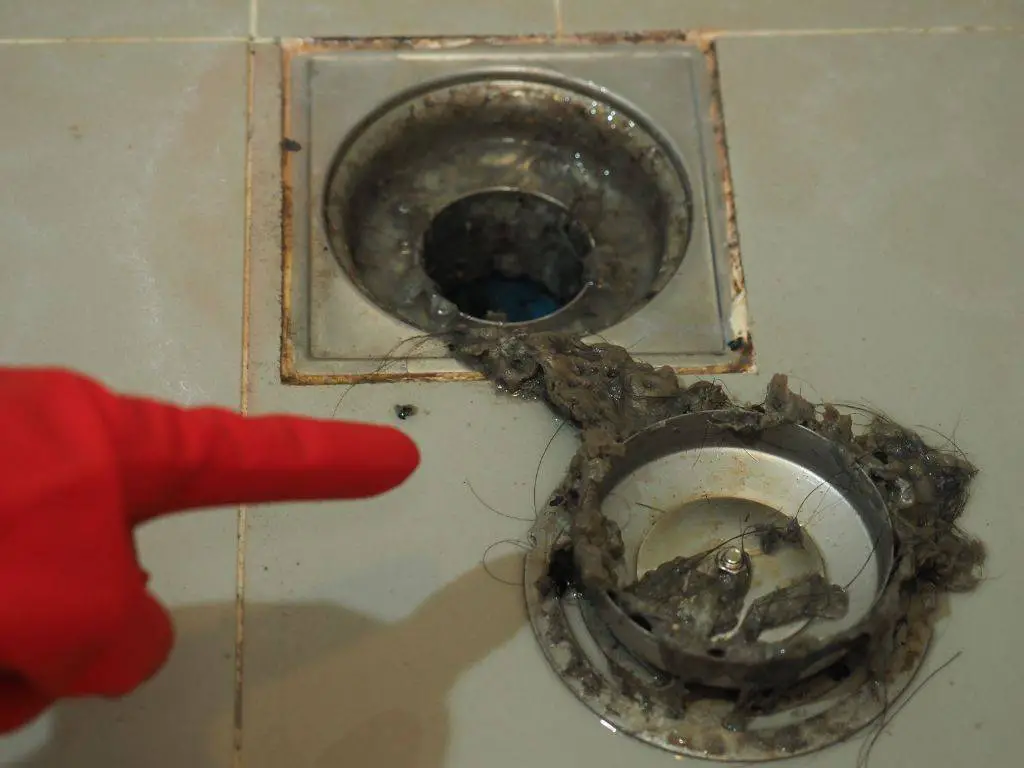
Small fly infestations often originate from bathroom and kitchen drains. To confirm this, you can seal the drain with tape for a day and check if any flies are trapped on the tape.
In bathrooms, dead skin cells and hair tend to accumulate in drains, providing an ideal breeding ground for small flies. The same happens with kitchen waste accumulation. Drain flies, for example, can penetrate into the organic film built-up along the wall of the drain and breed inside. Their maggots can’t be effectively killed by bleach or hot water.
The simplest way to address this is by thoroughly cleaning the drain. Brush the wall lining and try to dig out as much organic waste as possible. This will eliminate the breeding ground for small flies and solve your issue.
To assist in cleaning organic debris, you can use Invade Hot Spot. This foam-based product contains microbes that digest organic materials, which is ideal for cleaning hard-to-reach breeding ground in the drain.
Here’s how to use it: Wipe the floor trap or kitchen strainer dry, and seal it with masking tape or a similar material, leaving a small hole for injecting the foam. Inject the foam until it overflows. This ensures the pressure builds up and pushes the foam deep into the drain. Avoid using the drain for a few hours to allow the microbes to digest the organic buildup.
Please note that Invade Hot Spot is not an insecticide, and therefore, it doesn’t kill the fly larvae.
Use Drain Cover
Consider using a drain cover, such as Green Drain, at the floor trap. Green Drain allows water to drain while preventing pests from exiting the drain. Even if the drain becomes dirty again (which is likely), Green Drain prevents small flies and other pests from breeding inside and eliminates the risk of future infestations. Additionally, it acts as an odor barrier, blocking unpleasant drain odors that could attract flies.
Green Drain comes in multiple sizes to fit standard drains.
Clean Plumbing Trap
Cleaning the plumbing trap is another crucial step often overlooked. Small flies, like drain flies, can access and breed within plumbing traps. They hide beneath the organic film coating the pipes, preventing them from being washed away by water.
To address this, you can use an old toothbrush or metal brush to clean the plumbing trap and inner pipe walls. This method effectively removes small fly larvae and eliminates their breeding grounds without the need for insecticides.
Dry the Mop Head
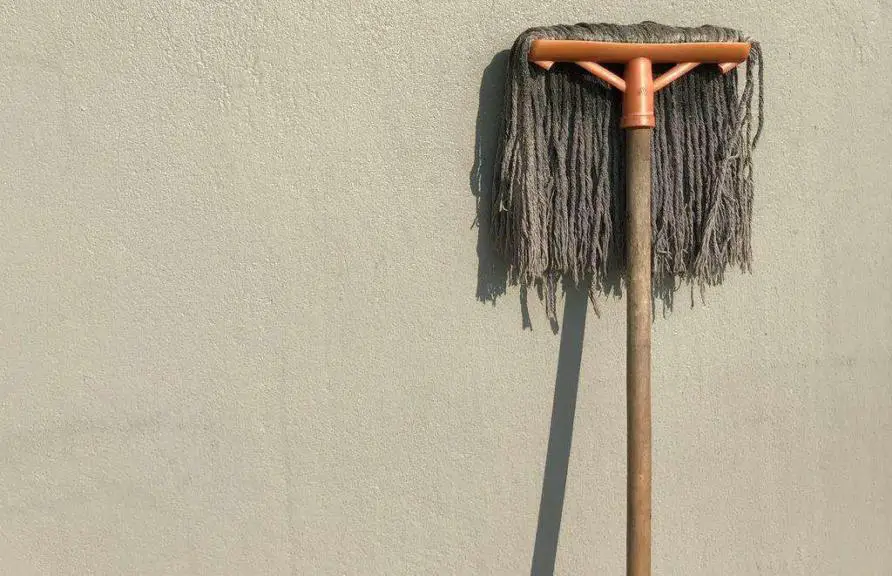
Mop heads tend to accumulate dirt and debris during use. If left damp, they can become ideal breeding grounds for small flies. To prevent this, always hang the mop or store it in a way that allows the mop head to dry quickly. This simple practice helps eliminate the conditions that attract and support fly infestations.
The same principle applies to brooms. If you store your broom in the washroom, ensure that the broom head doesn’t come into contact with water. When the broom head traps debris and water, it creates a perfect environment for fly larvae to thrive. To avoid this, store the broom in a manner that keeps the bristles elevated and dry.
Fix the Tiles and Grouts
When it comes to maintaining a clean and fly-free environment, even seemingly small details like the condition of your tiles and grouts can make a significant difference.
Broken or damaged tiles and grouts can trap water and debris, providing an ideal harborage for small fly larvae. By fixing any broken tiles and repairing damaged grouts, you eliminate potential breeding grounds for flies and contribute to a cleaner environment.
Improve Planter Box Drainage
It’s essential to check your planter boxes or pots if you are having small fly issues. Small flies can breed in excessively wet soil that contains a high amount of organic matter.
If you notice that your planter boxes or pots consistently have moist soil or mulch, improve the drainage. This not only eliminates the breeding grounds for flies but also promotes healthier plant growth.
Use Fly Swatter
Fly swatter is a cheap and efficient way to kill flies! I find it handy for killing flies around your dining table, where you do not want to spray chemicals. You might consider buying more than 1, because the plastic swatter can break if you smash too hard.
It’s worth noting that my personal experience with electric swatters for fly control has been less successful. While electric swatters are highly effective against mosquitoes, they seem to be less efficient when it comes to flies. Therefore, relying on a manual fly swatter is often a better choice for effectively eliminating flies in various settings.
Install Fly Traps
To tackle bothersome filth flies, installing fly traps can be a practical solution. These traps typically contain a food attractant to lure the flies and a sticky surface to capture them.
Fly traps prove especially useful when dealing with a significant infestation. However, if you’re only dealing with one or two flies, using a fly swatter would offer a better return on investment.
When it comes to placement, it’s ideal to position fly traps in areas where fly activity is evident. However, it’s essential to remove any objects that initially attract the flies to prevent competition with the traps.
For outdoor placement, aim to position the traps as far away from your house as possible. The objective is to lure the flies away from your living spaces rather than drawing them closer.
Two recommended products for fly trapping are Rescue! Pop! for outdoor use and Catchmaster Fly Ribbon for indoor use. These products are scented to attract filth flies. I don’t recommend using them for small flies. There are fruit fly traps in the market, but they are more suitable in a commercial setting.
Alternatively, you can create DIY fly traps using PET drink bottles. Cut the bottle horizontally at about one-third of its height from the top. Invert the top portion and place it into the base. Secure the bottle with tape, and your fly trap is ready. Add some food, such as fruit skins, diluted raw eggs, or spoiled food, to attract the flies into the trap.
Use a Fast Knockdown Aerosol Spray
When dealing with flies indoors, a space spray aerosol can prove highly effective in eliminating them indoors. I recommend using PT 565 Plus XLO. It contains pyrethrins, a substrate found in Chrysanthemum flowers. Pyrethrins offer a fast knockdown effect against flies. Additionally, the product includes piperonyl butoxide, a synergist that enhances the efficacy of pyrethrin.
It’s important to note that while pyrethrin is a natural substance, it is not suitable for food-grade applications. Therefore, never spray the aerosol near food.
Should I Use Zappers or Light Traps?
Flies are attracted by UV light. There are zappers and light traps that are marketed to trap or kill flies. While those traps are useful in killing flies, I don’t recommend this for homeowners because it is an overkill.
Installing such traps outdoors has limited efficacy. During the daytime when the flies are active, sunlight masks the UV light from the trap, making the trap unattractive to the flies.
How to Repel Flies
Fly repellents can be valuable tools for deterring flies and minimizing the risk of infestation. However, it’s important to note that while repellents can help prevent fly infestations to some extent, they may not fully resolve an existing infestation. In cases where the breeding ground is located within the area you want to protect, addressing the breeding ground is crucial.
To repel flies, use deodorizers on the sources of odors that attract flies, such as garbage dumps, kitchens, and washrooms. Deodorizers effectively neutralize the foul smell emanating from decaying waste, which serves as a strong lure for flies. If possible, removing the source of the odor entirely is highly recommended.
Various deodorizers can effectively mask the odors that attract flies. Personally, I find Fresh Wave Odor Eliminator to be a preferred choice due to its safety and versatility. This product features plant-based ingredients like pine needle, lime, clove, anise, and cedarwood, which are not only safe to use but also hold a Safer Choice label from the EPA. Fresh Wave Odor Eliminator can also be utilized on shoes and fabrics once the fly issue has been resolved.
It’s important to keep in mind that all repellents and deodorizers do not last long. Frequent reapplication is necessary to maintain their efficacy. While some companies offer diffusers that continuously dispense deodorizers, such options may be excessive for most homeowners.
Remember, repellents alone cannot fully address existing fly issues. It is essential to identify and eliminate the breeding grounds to effectively combat and prevent fly infestations. By combining repellents with targeted treatment of active infestations, you can significantly reduce the presence of flies in your living spaces.
Final Words
Getting rid of flies at home through DIY is simpler than you would have imagined. If you can’t handle the infestation though, make sure you get help from a pest control service provider. You can get a non-obligatory quote from your local service providers on Networx.
Lastly, do share my blog if you find it helpful!
Additional Information
How Long can Flies Live?
Generally, adult flies can live for 1 week to 2 months depending on species, sex, temperature and food to them. The development time from eggs to adults is another 1-7 weeks.
Typically, flies live longer at a lower temperature than higher temperature, and when there’s plenty of nutritious food. That’s why they have a much longer lifespan in the lab than in the field. Females tend to outlive males.
Since the lifespan of flies is affected by multiple factors, it is no surprise to see different numbers quoted by different sources.
How Far can Flies Fly?
Generally, larger filth flies can fly as far as 1-2 miles, while small flies tend to wander near their breeding ground. Hence, strategy to prevent filth flies at home often involves proofing entry points; while small flies prevention focuses on housekeeping and sanitation practices.
Why are Flies Dirty?
Flies are known to harbor 100 different germs. As a result, they are the carrier of multiple diseases such as cholera, typhoid fever, tuberculosis, conjunctivitis, anthrax etc.
Flies are dirty because of their habits. Filth flies love both decaying organic matter such as manure, compost and leaf litter. They pick up the germs and contaminants as they land and feed on their food. Those germs are transferred to human food as the flies land, regurgitate, and defecate on human food.
The body of filth flies are ideal for picking up germs because they have a lot of bristles on their body, which increases the contact surface. On top of that, they have sticky pads at the base of their legs to trap even more germs.
Flies have sponge-like mouthparts. They can consume only liquid food. To feed on solid food, flies regurgitate their saliva on the food to digest it externally. The flies can then suck the liquefied food. That sounds disgusting, isn’t it?
It was said that flies poop every time they land. This can be exaggerated, but flies defecate frequently. I am sure you want to avoid eating any food contaminated with poops, even if they contain no germs.
Can I Consume Food That a Fly Has Landed On?
It is generally safe to consume food that a fly has briefly landed on. However, if the fly has been on the food for an extended or unknown period of time, it is advisable to avoid eating it. The longer flies are in contact with your food, the greater the risk of contamination.
To prevent flies from landing on your food, it is wise to keep it covered at all times. Additionally, if you have concerns about contamination, you can opt to re-cook the food before consuming it.
Why do Flies Land on Me?
Flies are naturally attracted to the secretions and salts found on human skin, as they can serve as a source of nourishment for these insects. Furthermore, flies are drawn to areas with dead tissue, such as wounds, as well as the secretions and salts present around the eyes.
Where Flies Lay Their Eggs?
Flies typically lay their eggs on the food source that will nourish their larvae. The specific location for egg deposition varies depending on the species of fly. It can range from manure, leaf litter, food waste, rotting carcasses, fruits, to debris or organic matter present in drains, cracks, crevices, and gaps, and even wounds! The breeding ground needs to be adequately moist but not flooded, as flies do not lay eggs on dry surfaces.
